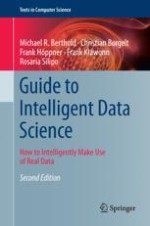Making use of data is not anymore a niche project but central to almost every project. With access to massive compute resources and vast amounts of data, it seems at least in principle possible to solve any problem. However, successful data science projects result from the intelligent application of: human intuition in combination with computational power; sound background knowledge with computer-aided modelling; and critical reflection of the obtained insights and results.
Substantially updating the previous edition, then entitled Guide to Intelligent Data Analysis, this core textbook continues to provide a hands-on instructional approach to many data science techniques, and explains how these are used to solve real world problems. The work balances the practical aspects of applying and using data science techniques with the theoretical and algorithmic underpinnings from mathematics and statistics. Major updates on techniques and subject coverage (including deep learning) are included.
Topics and features: guides the reader through the process of data science, following the interdependent steps of project understanding, data understanding, data blending and transformation, modeling, as well as deployment and monitoring; includes numerous examples using the open source KNIME Analytics Platform, together with an introductory appendix; provides a review of the basics of classical statistics that support and justify many data analysis methods, and a glossary of statistical terms; integrates illustrations and case-study-style examples to support pedagogical exposition; supplies further tools and information at an associated website.
This practical and systematic textbook/reference is a “need-to-have” tool for graduate and advanced undergraduate students and essential reading for all professionals who face data science problems. Moreover, it is a “need to use, need to keep” resource following one's exploration of the subject.
